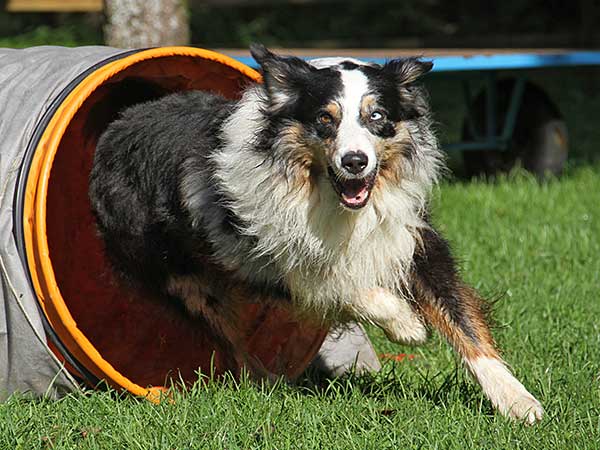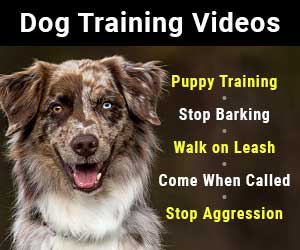
Dog Agility Tunnel of Fun
A dog agility tunnel is one of the more challenging and fun obstacles that you will find on any course. It is one of the most commonly used obstacles, so much so that you will generally find a tunnel is included in most basic agility sets. It may take some time to get your dog used to running through the tunnel but once you do, there is no more thrilling feeling than watching him zip through at top speed.
Tunnels have a standard competition measurement of 10-20 feet long with a 22-26 inch entrance. Length may vary if the course designer wants to include bends or curves in the tunnel. While the opening can range anywhere from 22-26 inches, the most common opening is 24". You can find practice tunnels to use for training that have even smaller openings, but you should never work with anything larger than the standard or this could hamper your dog in competition.
The tunnel itself has a frame, allowing it to retain its shape as the dog runs through. In some cases, a dog agility tunnel can be combined with a loose piece of material without a frame, called a chute, to increase difficulty.
Whether or not you use a dog agility chute it is important to remember that dogs may find the tunnel intimidating. Running into a long, narrow, dark space isn't something that all breeds have the instinct to do so it can seem frightening at first, but with a little work and encouragement, your dog should be able to get the hang of it fairly easily.

Sabine Glässl / stock.adobe.com
Dog Agility Tunnel Configurations
As mentioned above, tunnels can be laid out either in a straight line or in a curved or S shape for increased difficulty. Sometimes in competition tunnels will be wound around or even through other pieces of equipment, e.g. under an A-frame. That all depends on the course designer, but it is important for you to get your dog used to all sorts of tunnel shapes by working with them in practice.
You can connect two tunnels together to create longer courses or make more elaborate shapes. Some tunnels come equipped with a small flap that can be folded over a second tunnel for this purpose. If your tunnel doesn't have a flap, you can used binder clips that you can find in any office supply store to attach one tunnel to the other.
Since a dog agility tunnel can be used outdoors, it will need to stand up to the elements. Stakes can be used to keep the tunnel in place so that it doesn't blow in the wind or move around as your dog barrels through it. The fabric of the tunnel is also important. Most are made of heavy, weather and tear resistant fabric, but you can add another layer of protection by regularly spraying your tunnel with Scotchguard to increase its water repellant properties.
Use Rewards To Overcome Fear Of Tunnel
As with any piece of agility equipment, the key to teaching your dog to master a dog agility tunnel is using rewards and positive reinforcement. Each time your dog successfully completes the tunnel, give him a few words of praise and perhaps a treat. This will get the idea across that the tunnel is a fun and challenging obstacle to conquer and not something to be afraid of and may even make it one of your dog's favorite pieces of equipment.
Don't let tunnels intimidate you or your dog. Working together, you can both master this amazing piece of agility equipment and add it to your repertoire for a fun and exciting challenge!
Introducing Your Aussie To The Dog Agility Tunnel
The reaction to a tunnel can vary from one dog to another. Some love the idea and take to it almost instantly, while others may be a little more apprehensive about entering a relatively small opening. Either way, training your dog to use a tunnel can be a challenge, so you'll want to approach the concept slowly and carefully to help him get used to it.
It helps to introduce the idea of going through a dog tunnel opening by using a hula hoop. You can hold up the hoop with one hand and a treat with the other and encourage your dog to step through. Once he gets the feel of going through the hoop you can step him down by using smaller hoops, until you get to an opening that is the regulation tunnel size of 24 inches.
This is when you should introduce the actual tunnel, but you'll want to keep it compacted at first, again to get the dog used to the idea of walking through it without having to walk the full length. While you are working on this step you'll also want to incorporate a particular command, such as "through" or "tunnel" so that you'll be able to control your dog verbally while on the agility course.
Gradually you can increase the length of the dog tunnel until you finally get it expanded to its full length. After doing this in a straight pattern for a little while, you can then begin to set up the tunnel in different shapes, with bends or curves, which is how the tunnels will be set for competition. At each step in the process, you'll want to send your dog using the command you've created, so that you get used to a routine.
The tunnels are made from flexible material that gives as the dog runs through it to avoid injury. You can find both training and competition quality tunnels at most retail pet supply stores or online. You'll want to be sure that your tunnel is large enough for your dog to fit through comfortably and has no loose or jagged parts that he can get snagged on.
Because some dogs actually favor the tunnel, it is often set up in competition beside more difficult obstacles like the A-frame in order to force the dog to concentrate and avoid going off course. This can make the dog tunnel a challenge even for owners with enthusiastic dogs. For more timid dogs, the challenge is getting him over his anxiety about entering the small, enclosed space.
If you work closely and gently with your dog, you should have no trouble getting him used to the tunnel. In fact, you might even find that the dog tunnel becomes one of his favorite "toys" as he tears through it at top speed. And you'll have a sense of pride as you watch him and see just how far he's come!
United States Dog Agility Association, Inc. (USDAA)
Have Dog Training Questions?
Check out these introductory dog training videos...
I want my dog to stop being aggressive.
I want some help training my new puppy.
I want my dog to stop barking at everything.
Get Australian Shepherd Info, Website Updates, Special Offers, and Cartoons...
FREE GIFT
You'll also receive a free copy of the ebook
My Everyday Dog Training Tools
by professional dog trainer Daniel Abdelnoor, "Doggy Dan"












 Loading Image...
Loading Image...